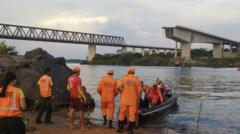The recent collapse of the Juscelino Kubitschek de Oliveira bridge in northern Brazil has sent shockwaves through the local communities, as immediate fears of harmful water contamination emerge. The disaster occurred over the weekend when the central span of the bridge, which connects the states of Tocantins and Maranhão, gave way, leading to the fall of eight vehicles, including three lorries loaded with thousands of litres of pesticides and sulphuric acid.
As rescue teams work tirelessly to recover the missing, reported to be more than 10 individuals, the tragic loss of four lives, including a young girl and a truck driver, has left families devastated. The initial shock of the event was compounded when local councillor, Elias Junior, recorded the moment the bridge collapsed while highlighting existing structural cracks. He expressed disbelief, stating that he never anticipated such an event during his visit to document the bridge's condition.
Local authorities are currently urging residents of Estreito and Aguiarnopolis, situated on either side of the river, to avoid collecting water for consumption, heightening the urgency for environmental assessments. Despite the ongoing search operations which have seen one man rescued alive from the water, diving operations to evaluate the extent of any chemical leakage have been halted amid safety concerns.
The more than 1,600-foot-long bridge, built in the 1960s, has long served as a critical transportation link across the Tocantins River, and its sudden collapse raises questions about infrastructure safety and regulatory oversight in Brazil. The situation continues to develop as communities come to terms with the tragedy and the potential environmental ramifications unfold.


















